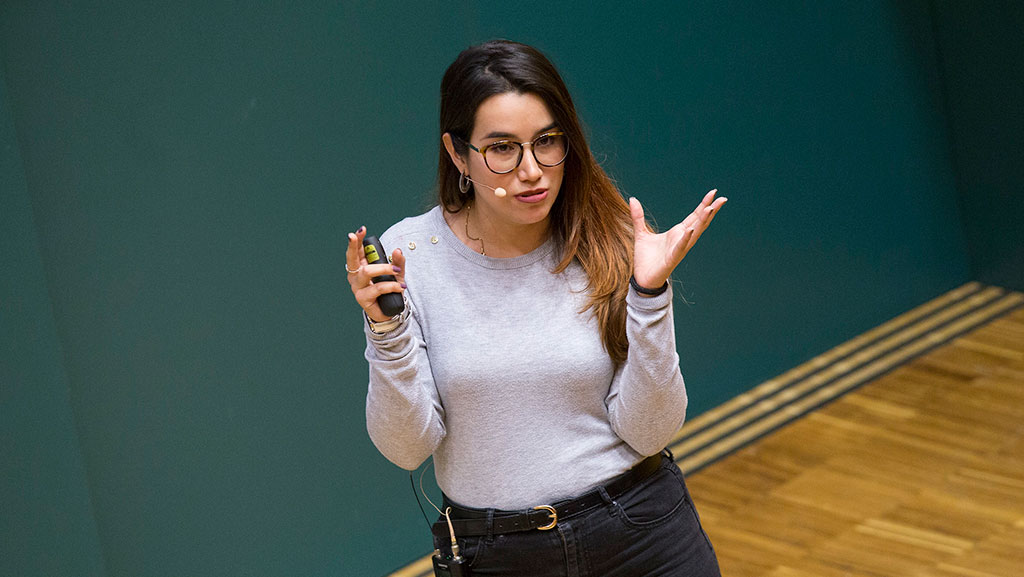Cristina Bustos , colombian researcher from IN3 group specializes in artificial intelligence
In 2015, the United Nations called upon governments and society as a whole to work towards the 17 Sustainable Development Goals (SDGs), which seek to improve people's and the planet's well-being in different areas. As part of its commitment to scientific progress and the SDGs, the UOC and its research groups are concentrating on projects that generate new knowledge and help improve the population's well-being. At the latest UOC Research Showcase, an event organized every two years by the University to share its scientific activity, the Colombian researcher Cristina Bustos was awarded the prize for best contribution to social transformation. Her project has the potential to improve pedestrian safety in large cities such as Madrid or Barcelona using artificial intelligence.
Cristina Bustos specializes in artificial intelligence and its uses with images. Originally from Colombia, for the last three years she has been living in Barcelona where she studied for her master's degree in Computer Vision. As a member of a research group affiliated with the UOC's Internet Interdisciplinary Institute (IN3), her work involves thinking about ways in which research can lead to social transformations. In this interview, we talk with her about her project, cooperation with government agencies and the huge challenges posed by a project of this magnitude.
In 2015, the United Nations called upon governments and society as a whole to work towards the 17 Sustainable Development Goals (SDGs), which seek to improve people's and the planet's well-being in different areas. As part of its commitment to scientific progress and the SDGs, the UOC and its research groups are concentrating on projects that generate new knowledge and help improve the population's well-being. At the latest UOC Research Showcase, an event organized every two years by the University to share its scientific activity, the Colombian researcher Cristina Bustos was awarded the prize for best contribution to social transformation. Her project has the potential to improve pedestrian safety in large cities such as Madrid or Barcelona using artificial intelligence.
Cristina Bustos specializes in artificial intelligence and its uses with images. Originally from Colombia, for the last three years she has been living in Barcelona where she studied for her master's degree in Computer Vision. As a member of a research group affiliated with the UOC's Internet Interdisciplinary Institute (IN3), her work involves thinking about ways in which research can lead to social transformations. In this interview, we talk with her about her project, cooperation with government agencies and the huge challenges posed by a project of this magnitude.
How can we improve pedestrian safety in large cities like Madrid and Barcelona?
Artificial intelligence can be used to predict the level of danger for pedestrians on the street. By combining urban images taken from online tools such as Google Street View and the accident rate data provided by each city's local council, we can train a neural network to find visual patterns related to the pedestrian accident rate in such images. There is a theory that an urban area's visual composition also affects accident causality and, through this project, we want to find these visual patterns so that we can modify or eliminate them, creating an urban design that is focused on road safety. All of this is possible thanks to enormous quantities of available data and techniques for analysing them. In our case, we have about a million images for Barcelona and Madrid.
Who has taken part in the research?
This project has been carried out by two of the UOC's research groups: Complex Systems @ IN3 (CoSIN3) and the Scene Understanding and Artificial Intelligence Lab (SUNAI). We have also received assistance from the government through the Directorate-General for Traffic (DGT), Madrid and Barcelona city councils, and academic contributors such as MIT and the Cartographic and Geological Institute of Catalonia.
What are the greatest challenges the project has had to overcome?
This project started without any precursors. There is no published literature on research into improving road safety using urban images. We have now completed two years of research. Certain phases, such as data collection (for example, talking with organizations so that they would provide us with the necessary data), creating and adjusting the artificial intelligence, and validating processes, have been very time-consuming. It has been a lengthy process but we’ve attained good results.
What's next?
We still have a lot of techniques to work on, test and improve. The field of artificial intelligence is moving forward at great speed and new techniques are constantly being developed. So, for the future, we want to try new things that will help us see more clearly into neural networks and also to use more advanced data structures, such as videos, instead of single images. We also want to include more cities in our study, including cities outside of Spain.
At the latest UOC Research Showcase, this project won the prize for best contribution to social transformation? What does this prize mean to you?
This prize means a lot to me and has motivated me to continue. I've always wanted to use artificial intelligence to build tools that improve people's lives. So, I'm very happy to be able work on a project that seeks to improve a specific aspect of road safety, namely, pedestrian safety.
Press contact
-
Editorial department

